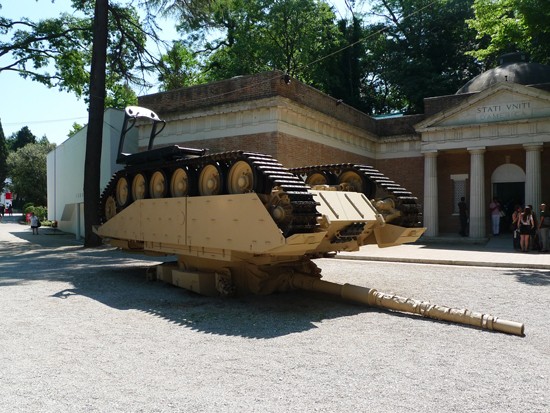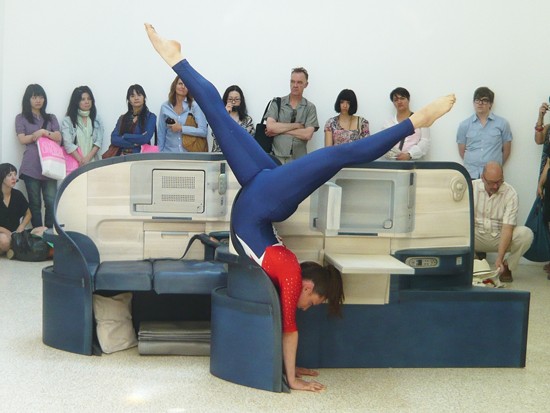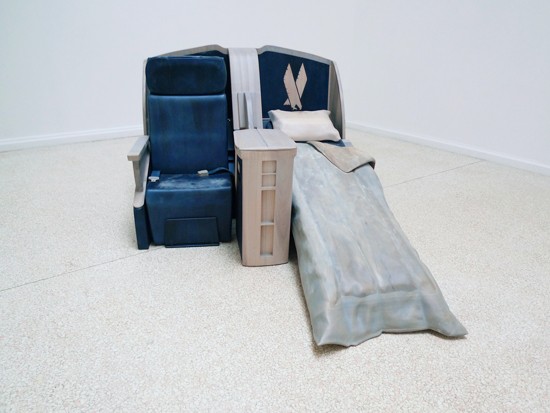Dan Cameron previews Allora & Calzadilla’s US Pavilion at the 54th Venice Biennale.
 Installation view of Track and Field (2011) outside the US Pavilion at the Giardini, Venice, 2011. All images: Photo ART iT.
Installation view of Track and Field (2011) outside the US Pavilion at the Giardini, Venice, 2011. All images: Photo ART iT.The choice of Allora & Calzadilla to represent the US at the Venice Biennale this year is boldly significant, and for many reasons. It’s been quite some time since the American representation in Venice wasn’t of an artist of near-mythic importance, like Nauman, Ruscha or Gonzalez-Torres, and the fact that neither the artists nor the presenting institution – the Indianapolis Museum of Art – are securely established within the recent iconography of American art suggests a more thorough appreciation, at the level of the US State Department, for the features emphasized by other pavilions in Venice, which generally focus on the most late-breaking developments in the art of their home countries.
This premise entails a certain degree of risk, and, as evidenced by the last couple of times the US Pavilion was turned over to an American artist of status comparable to that of Allora & Calzadilla, it doesn’t always pay off. In 1999, Ann Hamilton gutted the Pavilion and transformed it into a continuous series of subtly tactile installations incorporating Braille, red pigment and dripping fluids, and got clobbered by the press for her literalism (I personally thought it was sublime). Fred Wilson’s Pavilion in 2003 attempted to simulate the life of an African immigrant getting by in today’s Venice, and he suffered a similar fate from commentators who dismissed the work as too politically correct. Indeed, the reason the US Pavilion has tended to be given over to sacred cows, producing very compelling projects – Bruce Nauman’s in 2009 was certainly formidable – is that the formula of unassailable artists showing important works has been successful, if at times quite predictable.
Much has been made in the press about Jennifer Allora and Guillermo Calzadilla being the first artists representing the US to come from Puerto Rico, and that they are the first who incorporate performance as a primary platform (the Hamilton year notwithstanding). But what makes their work especially meaningful at present has more to do with their freewheeling approach to their materials, and their capacity to elucidate the essence of the symbols they use. From “Gloria,” the title of their Venice tour de force, the piece that has provoked the most advance Giardini chatter is Track and Field, a 60-ton military tank flipped over on its back, with a fully functioning treadmill on top. The piece comes alive when it is being used by one of the participating runners from USA Track & Field, who will run at regular intervals throughout the exhibition period.
Performers abound in Allora & Calzadilla’s Venice project, but they aren’t typical of the dancers and actors who tend to appear in the performance art genre. In an effort to transcend conventional boundaries between the visual and performance traditions, the artists have enlisted as their collaborators a handful of runners and gymnasts who compete (or have competed) for medals for the United States. The premise seems to be that the level of their physical achievement is such that by simply carrying out their separate male and female gymnast routines in different rooms of the Pavilion for the works Body in Flight (Delta) and Body in Flight (American) (both 2011) – action centered on life-size polychrome wooden sculptures of business-class seats from the eponymous competing airlines – the athletes offer the closest thing to a physical perfection of form and movement. There is also a deeper subtext to their choice of performers that, I believe, has to do with the embodiment of high levels of physical skill and daring, and the fact that such achievement can easily be overlooked when a country becomes overly militarized.

 Top: Performance view of representative from USA Gymnastics with Body in Flight (Delta) (2011) in the US Pavilion at the Giardini. Bottom: Installation view of Body in Flight (American) (2011) in the US Pavilion at the Giardini.
Top: Performance view of representative from USA Gymnastics with Body in Flight (Delta) (2011) in the US Pavilion at the Giardini. Bottom: Installation view of Body in Flight (American) (2011) in the US Pavilion at the Giardini.While such collaborations with highly advanced practitioners of their respective performing artforms has become an important hallmark of Allora & Calzadilla’s work, the most startling part of their Venice Pavilion is how crystal clear the work’s political message is. One of the recurring themes in their work to date has been the fate of the Puerto Rican island of Vieques, which until 2003 was used for US naval exercises, and is now being rehabilitated and adapted for its post-military existence as a tourist destination. Vieques’ story in many ways symbolizes the guns-to-plowshares dilemma facing the United States in the world today, in which questions of the appropriate use of power surround the catastrophe that is the Iraq War, which has cost the lives of hundreds of thousands of people and displaced millions, and was based entirely on distorted intelligence about Saddam Hussein’s development and potential use of weapons of mass destruction.
It is probably not an exaggeration to say that the ongoing Iraq War, which remains the most egregious of the US’s failed policies during the Bush administration, haunts the current generation of American artists and intellectuals, and Allora & Calzadilla’s embrace of Vieques as a symbol of the waste and destruction that occurs when the military-industrial complex drives US policy examines the same problem from a more intimate viewpoint. This is probably the most important reason why the choice of their work is so important, because it can be interpreted as a rejection by the current US State Department of the dogmatic, narrow rhetoric employed by the previous president to justify what has become the wholesale destruction of Iraq.
Despite these points, Allora & Calzadilla’s representation of the US should be significant for visitors to Venice because of their role as innovators. Although it might not be quite as spectacular as Track and Field, the work Algorithm seems to examine the crash of world financial markets in late 2008 and early 2009, which brought on a worldwide recession. It is now generally accepted that culpability for the recession lies with unscrupulous bankers and lax regulatory oversight, which led to the spectacle of vast amounts of debt being leveraged on the basis of bundled mortgage loans that were unstable, and in many cases downright predatory. In Algorithm, Allora & Calzadilla give us a pipe organ whose inner workings are connected to a functioning ATM, with the result that when someone begins the process of withdrawing money, the pushing of buttons is translated (via algorithms) to commands to the organ, which are in turn transformed into music. The idea that money has replaced religion as the focus of cultural worship is hardly a new one, but the transformation of a private financial transaction into a public musical display suggests that a different kind of transparency about financial activity might have prevented the most recent crisis, and should serve as safeguards against a future repeat of the same scenario.
To over-emphasize the political aspects of Allora & Calzadilla’s work risks understating its extraordinary wit and grace, which are probably the qualities that viewers are most likely to take away with them. But the emphasis on relatively untested artists using such distinctive artistic practices (and collaborators) to make a unified project that undercuts the recent efforts of the US to bully the rest of the world through military force (either real or presumed) indicates that progress and change are not only possible, but essential to how art functions within a social context.
The 54th Venice Biennale, “ILLUMInations,” opens to the public June 4 and continues through November 27.
Return to story index
Venice Biennale – ILLUMInations: 54th International Art Exhibition
